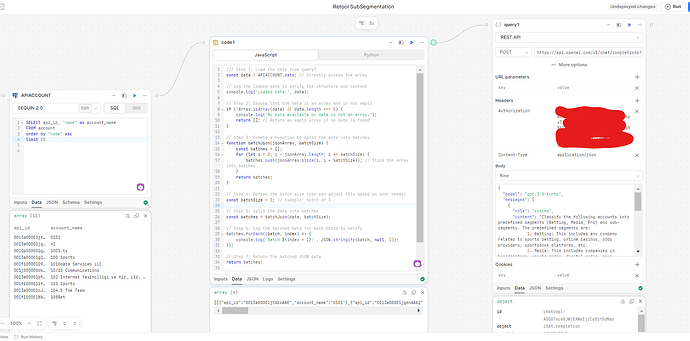Hi,
I am wanting to send account data from my postgres instance to my openapi to populate segment sub segment data. The dataset I have is pretty large so I want to do this in batches. I cant get the rest api to iterate through the batches? Any idea what I am doing wrong?
Thanks
This is what I have done -
Step 1 -
SELECT api_id, "name" as account_name
FROM account
limit 50
Step 2 -
Loop sql query batch size 10
Step 3 -
Convert loop to Json
/// Step 1: Load the data from query7
const data = APIACCOUNT.data; // Assuming query7.data is already formatted as an array
// Log the loaded data to verify
console.log('Loaded data:', data);
// Step 2: Transform the data to NDJSON format
const ndjson = data.map(item => JSON.stringify(item)).join('\n');
// Log the transformed NDJSON data to verify
console.log('NDJSON data:', ndjson);
// Step 3: Return the transformed data
return ndjson;
Step 4 -
REST API to OPENAPI as follows
{
"model": "gpt-3.5-turbo",
"messages": [
{
"role": "system",
"content": "Classify the following accounts into predefined segments (Betting, Media, Pro) and sub-segments. The predefined segments are:
1. Betting: This includes any company related to sports betting, online casinos, odds providers, sportsbook platforms, etc.
2. Media: This includes companies in broadcasting, sports media, digital media, news agencies, TV stations, and OTT platforms.
3. Pro: This is for any company related to professional sports organizations, such as teams, leagues, federations, and stadiums.
The sub-segments under these categories are:
- Betting: Sportsbook, 3rd Party Betting Partner, Fantasy, Gaming & Affiliates, Professional Bettors & Syndicates.
- Media: Digital Media & Websites, Tech, Brands & Agencies, Broadcaster / OTT, Academia.
- Pro: Team, College / University, League / Federation, Player Agents, Pro Partner."
},
{
"role": "user",
"content": "Please classify the following accounts and return the result as a JSON object with keys 'api_id', 'account_name', 'segment', and 'subsegment' for each account. Here are the accounts: {{code1.data}}"
}
]
}



